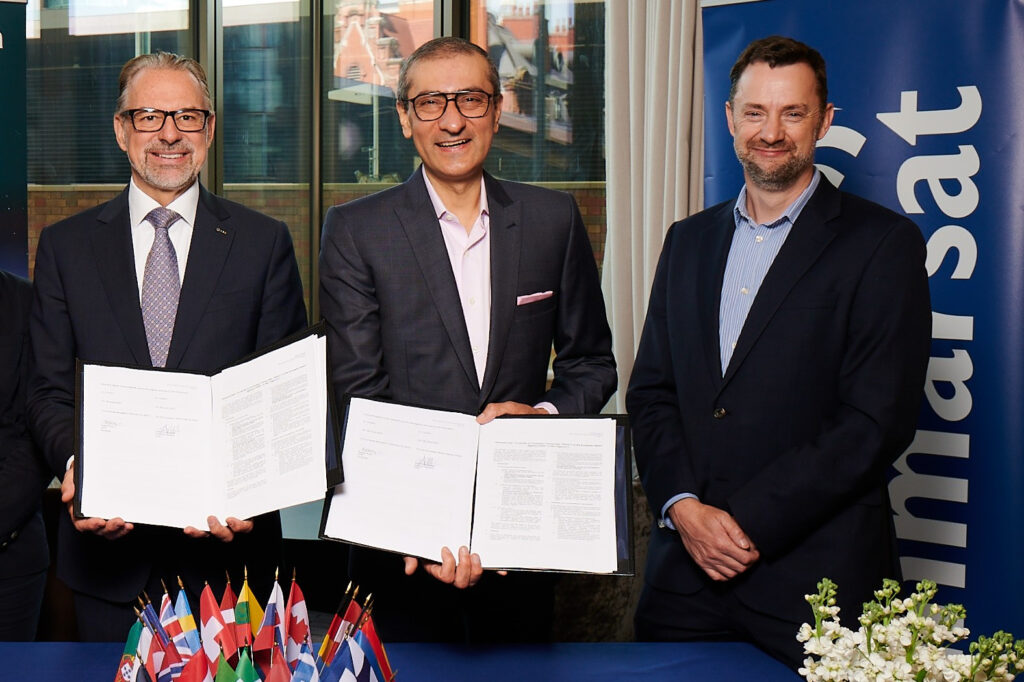 The congestion of airspace around the world is increasing rapidly, and pressure is mounting on the aviation industry to seek more sustainable practices. In Europe alone, skies are expected to see a 50% increase in flights in the next 20 years – while recent estimates anticipate 40 times more commercial UAVs will be flying beyond visual line-of-sight by 2030 than commercial aircraft.
The congestion of airspace around the world is increasing rapidly, and pressure is mounting on the aviation industry to seek more sustainable practices. In Europe alone, skies are expected to see a 50% increase in flights in the next 20 years – while recent estimates anticipate 40 times more commercial UAVs will be flying beyond visual line-of-sight by 2030 than commercial aircraft.
That’s why Inmarsat and the European Space Agency (ESA) have signed a new contract focusing on the globalisation of their ground-breaking Iris air traffic modernisation programme.
This new phase, Iris Global, will focus on the technologies and certification required to share the fuel, CO2, and congestion-saving benefits of Iris with regions far beyond Europe. To further accelerate ATM modernisation, it will also adopt System Wide Information Management (SWIM) applications to facilitate greater sharing of information such as airport operational status, weather information, flight data, and status of any airspace restrictions. In addition, research on future capabilities for the integration of uncrewed aviation into European airspace will be supported.
Iris, developed in a public-private partnership launched by ESA, is a service operating on Inmarsat’s SB-S platform. It was created to deliver powerful benefits to airlines and Air Navigation Service Providers (ANSPs) by enabling high bandwidth and cost-effective satellite-based datalink communications between air traffic controllers and pilots.
Entering commercial and operational service in Europe in 2023, Iris will be the first communication service benefiting from a Pan-European certification from EASA, the European aviation safety agency. It allows aircraft to send and receive live data with ground systems during the entire flight, enabling increased predictability of operations and the ability to adapt to evolving conditions on the air traffic network, thus making Air Traffic Management (ATM) more effective and safer.
Iris will be a key enabler for trajectory-based operations to be implemented through the sharing of four dimensional (4D) trajectory data between the aircraft and the ground. Initial 4D trajectories will enable optimised climb and descent pathways – but also allow for en route optimisation of the trajectory, creating fuel and CO2 emissions savings. Iris makes use of the International Civil Aviation Organization’s (ICAO) Aeronautical Telecommunication Network (ATN) standards, including those suitable for future ATM and ATN Open Systems Interconnect (ATN OSI) protocols, enabling ground-breaking new ATM functionalities such as 4D trajectory management to be deployed.
Rajeev Suri, Chief Executive of Inmarsat, said: “Capacity crunches are a major issue worldwide – and relying on existing technologies alone won’t solve the problem. Iris will have an enormous impact in Europe as it enters service in 2023, which is set to continue at pace as air travel increases and the push for more sustainable aviation operations grows. It’s a natural next step for us to expand its remit beyond European airspace and share our spoils with the rest of the world. To beat capacity issues and make aviation greener long-term, as well as successfully integrate UAVs into our airspace as soon as possible, we need the right technologies on board every aircraft – and this starts with Iris.”
Josef Aschbacher, ESA’s Director General, said: “Iris is a major step towards creating a more sustainable and efficient aviation industry. It is exciting to see the progress made so far – but this is only just the beginning. Iris Global will extend the benefits of innovation and operational efficiency beyond Europe to other parts of the world. Reaching carbon-neutrality for air traffic management by 2050 will be challenging, but we hope to contribute through innovation in space to achieve this ambitious goal.”
Iris is backed by a company called the European Satellite Services Provider (ESSP), which was founded by seven national air traffic control organisations from France, Germany, Italy, Portugal, Spain, Switzerland and the UK. The company is the first air navigation service provider to own a pan-European certificate to allow cross-border delivery of air traffic management services.
Charlotte Neyret, Chief Executive Officer of ESSP, said: “The Iris programme is a game-changer for the aviation industry, providing the most advanced new technology to complement datalink communications and meet the challenge of digital, greener and more sustainable air travel. As a stepping stone for the future datalink service provider organisation under discussion, ESSP is proud to lend its expertise on this important programme that will deliver a pan-European certified service for the first time.”
For the fully global Iris solution, Inmarsat, the world leader in global mobile satellite communications, will work with industry partners and standards organisations to also implement next-generation ATN/IPS (Aeronautical Telecommunication Network using Internet Protocol Suite) satellite communications, which are currently being finalised as the global standard for air traffic control communications to and from the aircraft. Iris Global will build a seamless ATN/OSI to ATN/IPS gateway, allowing all aircraft, no matter which of the two standards they operate on, to fly seamlessly across the globe.
ABOUT INMARSAT
Inmarsat is the world leader in global, mobile satellite communications. It owns and operates the world’s most diverse global portfolio of mobile telecommunications satellite networks, and holds a multi-layered, global spectrum portfolio, covering L-band, Ka-band and S-band, enabling unparalleled breadth and diversity in the solutions it provides. Inmarsat’s long-established global distribution network includes not only the world’s leading channel partners but also its own strong direct retail capabilities, enabling end to end customer service assurance.
The company has an unrivalled track record of operating the world’s most reliable global mobile satellite telecommunications networks, sustaining business and mission critical safety & operational applications for more than 40 years. It is also a major driving force behind technological innovation in mobile satellite communications, sustaining its leadership through a substantial investment and a powerful network of technology and manufacturing partners.
Inmarsat operates across a diversified portfolio of sectors with the financial resources to fund its business strategy and holds leading positions in the Maritime, Government, Aviation and Enterprise satcoms markets, operating consistently as a trusted, responsive and high-quality partner to its customers across the globe.
ABOUT ESA
The European Space Agency (ESA) is Europe’s gateway to space. ESA is an intergovernmental organisation, created in 1975, with the mission to shape the development of Europe’s space capability and ensure that investment in space delivers benefits to the citizens of Europe and the world. For more information see esa.int.
The Telecommunications and Integrated Applications Directorate (TIA) supports innovation to boost the competitiveness of European industry in the global space market. This involves a wide range of activities, from space-based technology, systems, products for telecommunications development to the down-to-Earth application of space-based services. It also calls for engagement with a wide range of industrial, academic, and institutional partners.
ABOUT ESSP
ESSP SAS (European Satellite Services Provider) is a European private company. ESSP acts as the service provider for EGNOS, the European Geostationary Navigation Overlay Service. The company is based in Toulouse (France) and Madrid (Spain).
ESSP’s contributes to the digitalisation of Communication, Navigation and Surveillance (CNS) services with the implementation of such projects on a pan-European scale. This will be achieved through space-based communication means, taking into account the experience gained from the successful EGNOS service model for the benefit of Airspace Users and finally European citizens.
All images credited to Inmarsat










